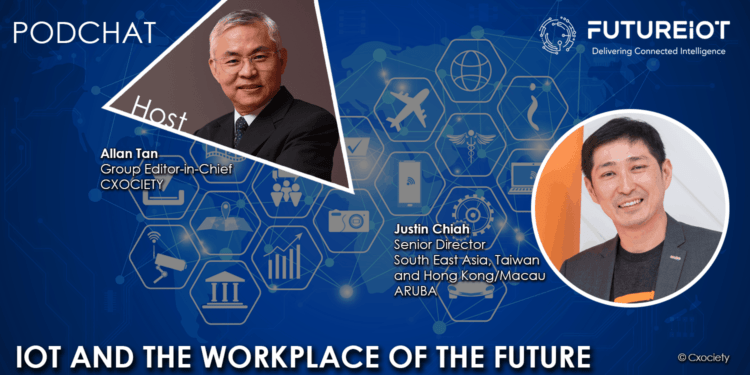There is renewed interest around it as organisations look to implement return-to-work policies and processes. But what exactly would IoT bring to the organisation? How do you ensure that IoT does not violate personal privacy?
As the world turns to greet 2021, Forrester warns of big network connectivity chaos ahead. At the same time, it sees the Internet of Things (IoT) as helping companies and employees transition to a smart working environment as they return to the office – even if we still don’t know when a full return to the office becomes real.
In this episode of FutureIoT, we speak to Justin Chiah, senior director, South East Asia, Taiwan and Hong Kong/Macau at Aruba for his views on IoT in the workplace of the future.
Smarter, safer workplace
Justin Chiah: The two goals that I talked about – improving efficiency and creating the right experiences are critical. There are a plethora of new IoT devices coming out particularly in the manufacturing space.
Conditional monitoring and predictive maintenance are two critical functions. Typically, when you look at the lifecycle of production floor equipment, you don’t really find problems at the start of the lifecycle of that equipment. What happens is that when the equipment depreciates, problems will only start to appear.
What if there is a way for smart sensors to understand equipment deterioration only as and when it is needed, and you apply the resources accordingly. Therefore, you create a lot more efficient approach to that – so that is a concept that is prevailing across how IoT can help in the workspaces.
Challenges for integrating IoT with IT
Justin Chiah: Operational technology (OT) remains as a domain of the OT team so to speak. What has changed is because we want to make it addressable – an IT addressable factor to it.
There is an issue in the handover – there is a need for any IT systems, networks, in particular, to really not create two bifurcated networks – one that allows for a network that is intelligent enough, secure enough so that we can bring in IoT networks as part of our day-to-day functioning of IT systems. That’s critical.
If you look at IoT, one of the greatest issues or concerns for a lot of people is the attack surface area. Because IoT typically was never designed for security in mind. It is always designed in a sense to collect data. And sometimes, what that means is that the onus in making sure that the devices are secured on the IT side of the network layer.
Questions C-suites must address with IoT integration
Justin Chiah: If you look at IoT, there are a lot of productivity benefits if we are talking about efficiency and creating better experiences. One that needs to be done is called a reassessment. How can you have the right framework and paradigm to deal with the reassessment better? That means a couple of things: First, these are complications and the load they have on the IT teams.
Second, is the concern around security: “How do IoT devices come in?” Because you've heard many unfortunate headline-grabbing exposes that come about from a wrongly provisioned or ill-intended IoT device that was compromised.
Third, the portion is that IoT is supposed to bring about a lot of new changes on productivity, but it also should be incorporated in an improved workflow for the IT teams as well. The concern around or the ability to automate some of the more menial tasks to help IT teams who need to administer the IoT devices in the workplace to really focus on the outcomes rather than the menial day-to-day groundwork.
During the PodChats for FutureIoT dialogue, Chiah shares his opinion on the following key issues:
- In the context of IoT, what is Aruba all about? (edge to cloud, intelligent edge)
- How do you make the workplace smarter while saving operational costs?
- What are the challenges faced by IT as organisations look to put a structure in the use of IoT in the workplace?
- What would be the top 3 questions leadership need to ask before deciding to install IoT in the workplace?
- COVID-19 – how do you implement processes that would protect the health and safety of employees while protecting the privacy of staff?
- What are the essentials/tools that they should be focusing on and how do these intersect with IoT?
- What are the other innovations we can expect as organizations embrace hybrid workplace?
Click on the podchat player above to listen to his responses in full.



